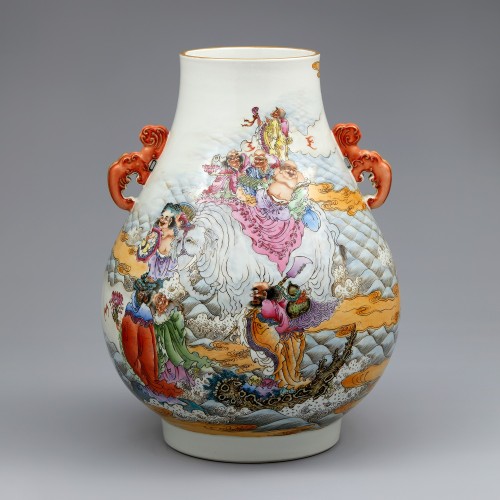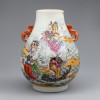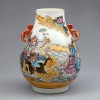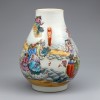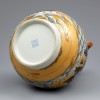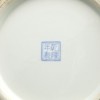본문
흰색 유약이 시유된 몸체 위에 분채 안료로 신선도(神仙圖)가 가득 그려져 있습니다. 어깨 양쪽에는 이룡(螭龍) 형태의 귀가 달린 청나라 준(尊)입니다. '준'은 청동기에서 유래된 제기(祭器)로, 제사를 지낼 때 술을 담는 그릇의 일종입니다.
신선도(神仙圖)에는 팔선(八仙)을 비롯해 도교, 불교, 민간 신앙과 관련된 총 18명의 신선들이 등장합니다. 이는 불로장생과 장수, 복, 권위를 상징하는 길상적 도상입니다. 중국에는 500명이 넘는 신선이 있다고 전해지며, 이처럼 다양한 신앙의 신선들을 한데 모아 여러 의미를 담아낸 유물들이 많이 제작되었습니다.
유물 중심부에는 네 명의 신선이 흰 코끼리를 타고 있으며, 코끼리는 불교에서는 부처의 신성함을, 도교에서는 신선의 탈것으로 여겨지는 상징적 동물입니다. 코끼리 아래에는 팔선 중 한 명인 철괴리(鐵拐李)가 보입니다. 그는 병자를 구제하고 자비를 실천하는 신선으로, 등에 짊어진 호리병에는 불사약이 담겨 있다고 전해집니다. 반대편에는 유일한 여성 팔선인 하선고(何仙姑)가 해태를 타고 있으며, 험상궂은 얼굴로 호랑이를 탄 신선과 괴기스러운 표정의 인물이 함께 표현되어 있습니다. 이들은 도를 수호하는 신선들로 해석됩니다.
유물 하단을 따라 흐르는 파도와 구름은 신선들이 선계(仙界)로 향하는 여정을 상징하며, 이는 초월과 도(道)의 여정, 협력과 수호의 이상 세계를 표현한 것입니다.
어깨 양쪽에 부착된 이룡(螭龍) 귀는 고귀함과 길조를 상징하는 장식으로, 이룡은 전설 속의 어린 용으로서 성숙한 용과는 달리 날개가 없으며 유연하고 민첩한 형태를 가집니다.
전체적인 기형은 아래로 둥글게 퍼진 안정적인 굽형 원통 구조로 되어 있으며, 굽 바닥에는 '건륭년제(乾隆年製)'라는 관지가 새겨져 있어 이 유물이 청나라 건륭 시기에 제작되었음을 알 수 있습니다. 표면은 광택이 매우 뛰어나고, 화려하여 황실이나 귀족이 사용했던 유물로 추정됩니다.
━━━━━
此尊通体施白釉,上以粉彩绘满神仙图。肩两侧饰螭龙耳。尊形制源自青铜礼器,原为祭祀时盛酒之器。
所绘神仙图中,共有十八位神仙形象,涵盖八仙以及道教、佛教和民间信仰中的仙人,寓意长生不老、福寿与权威。中国传说中有五百余位神仙,此类集诸仙于一器的纹饰,蕴含多重吉祥寓意,颇为常见。
器身中央绘有四位神仙乘白象而行。白象在佛教中象征佛之神圣,在道教中亦为仙人之坐骑。白象下方为八仙之一的铁拐李,其肩负葫芦,内藏不死之药,象征救济病患与慈悲。另一侧为唯一的女仙何仙姑,骑瑞兽獬豸而来。其旁有面容狰狞、骑虎之仙人,以及表情诡奇的护法神像,皆为守护仙道之象征。
器身下部绘海涛与祥云,象征神仙升入仙界的旅程,寓意超脱尘世、修道求真,以及协作守护的理想境界。
器肩附螭龙耳。螭龙为传说中未成年的幼龙,无翼而形态柔婉,常寓意高贵与吉祥。
器形整体呈下敛上收的鼓腹圆筒式,器底刻“乾隆年制”款,表明其为清代乾隆时期御制之作。其釉面光润华美,纹饰繁丽,推测为皇室或贵族所用之器物。
━━━━━
The vessel is a Qing dynasty zun (ritual wine container) modeled after ancient bronzes, its body coated in a brilliant white glaze and decorated in famille rose enamels with a Scene of Immortals. On both shoulders are applied chilong (螭龍) handles, representing young dragons that symbolize nobility and auspicious fortune.
The immortal scene depicts a total of eighteen figures drawn from Daoism, Buddhism, and popular beliefs, including the Eight Immortals. These figures are auspicious emblems of longevity, prosperity, and authority. Chinese lore speaks of more than five hundred immortals, and many works of art were created bringing together such diverse figures into a single symbolic composition.
At the center of the decoration, four immortals ride a white elephant. In Buddhism, the elephant represents the sanctity of the Buddha, while in Daoism it is seen as a mount for immortals. Beneath the elephant appears Tieguai Li (鐵拐李), one of the Eight Immortals, carrying a gourd said to contain the elixir of immortality. Opposite him, the female immortal He Xiangu (何仙姑) rides a mythical beast (xiezhi, 獬豸), while another fierce immortal astride a tiger and a grotesque figure nearby are understood as guardians of the Dao.
Around the lower section, waves and clouds flow in continuous bands, symbolizing the immortals’ journey to the celestial realm. This imagery conveys transcendence, the pursuit of the Dao, and the ideal of harmony and protection.
The chilong handles applied to the shoulders are decorative symbols of auspiciousness and nobility. Unlike mature dragons, chilong are legendary juvenile dragons, wingless, supple, and agile in form.
The vessel itself takes the form of a stable cylindrical body spreading outwards towards the foot. On the base is inscribed the six-character reign mark “Made in the Qianlong Period” (乾隆年製), indicating its manufacture during the reign of the Qianlong Emperor. With its brilliant enamel finish and splendid decoration, the work is presumed to have been made for use in the imperial court or by the aristocracy.
